Hendrick van Steenwyck the Younger stands as a pivotal figure in the development of architectural painting in Northern Europe during the late 16th and early 17th centuries. Born into an artistic lineage, he not only inherited his father's specialized subject matter but also propelled it to new heights of sophistication and popularity, particularly through his intricate depictions of church interiors and imaginary palaces. His work, characterized by meticulous detail, masterful perspective, and evocative use of light, captured the imagination of patrons across the continent, including the English court, and left a lasting legacy on the genre.
Early Life and Artistic Heritage
Hendrick van Steenwyck the Younger was born around 1580, likely in either Antwerp or possibly Frankfurt am Main. The exact location remains a point of scholarly discussion, reflecting the peripatetic nature of many artists' lives during this period, often influenced by religious and political upheavals. He was the son of Hendrick van Steenwyck the Elder (c. 1550–1603), himself a pioneering painter of architectural interiors. The elder Steenwyck was a pupil of the influential Dutch artist and architect Hans Vredeman de Vries, whose theoretical works on perspective and architectural design profoundly shaped the genre. Thus, the younger Steenwyck was immersed in the principles of architectural representation from his earliest years.
His father had moved the family from the Southern Netherlands, likely due to the religious strife following the Beeldenstorm (Iconoclastic Fury) and subsequent Spanish persecution of Protestants. Many Flemish artists sought refuge in more tolerant German cities like Frankfurt, which became a vibrant center for émigré artists and intellectuals. It was in this environment, under his father's direct tutelage, that Hendrick the Younger would have received his initial artistic training, learning the complex techniques of linear perspective and the detailed rendering of architectural forms that would become his hallmark.
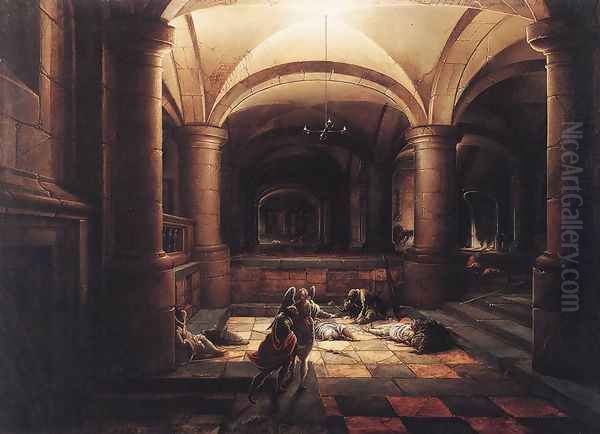
The distinction "the Younger" is crucial for art historians to differentiate his oeuvre from that of his father, as their subjects and styles share considerable similarities. However, the younger artist would go on to develop a more refined and often more atmospheric approach, particularly in his handling of light and shadow, and would achieve even greater international recognition. His active period is generally considered to be from around 1603, the year of his father's death, until his own passing in 1649.
Development of a Specialized Genre
Hendrick van Steenwyck the Younger, alongside his father, is credited as one of the earliest Netherlandish painters to specialize almost exclusively in architectural interiors. This focus marked a significant departure from the prevailing traditions where architectural settings often served merely as backdrops for religious or historical narratives. In the hands of the Steenwycks, the architecture itself became the primary subject, celebrated for its grandeur, complexity, and symbolic resonance.
They particularly favored depicting the interiors of Gothic churches, with their soaring vaults, slender columns, and intricate tracery, as well as imaginary Renaissance-style palaces. These were not always faithful representations of existing buildings but were often idealized or composite constructions, allowing the artist greater freedom to explore dramatic perspectives and lighting effects. The meticulous attention to detail in rendering stonework, stained glass, and decorative elements lent a remarkable sense of realism and tangibility to these often-fantastical spaces.
The younger Steenwyck built upon his father's foundations, often working on a smaller scale with even finer execution. His paintings are characterized by a sophisticated understanding of linear perspective, creating a convincing illusion of depth that draws the viewer into the painted space. He was particularly adept at depicting nocturnal scenes or interiors illuminated by artificial light sources such as candles or torches, a skill that allowed him to create moods ranging from serene contemplation to mysterious drama.
Key Artistic Centers: Antwerp, Frankfurt, and London
Van Steenwyck the Younger's career saw him active in several major European artistic centers, reflecting both his growing reputation and the interconnectedness of the art world at the time. After his initial training, likely in Frankfurt, he is recorded in Antwerp by 1604, where he became a master in the Guild of Saint Luke, the city's prestigious painters' guild. Antwerp was then a leading artistic hub, and his presence there would have exposed him to the work of prominent contemporaries.
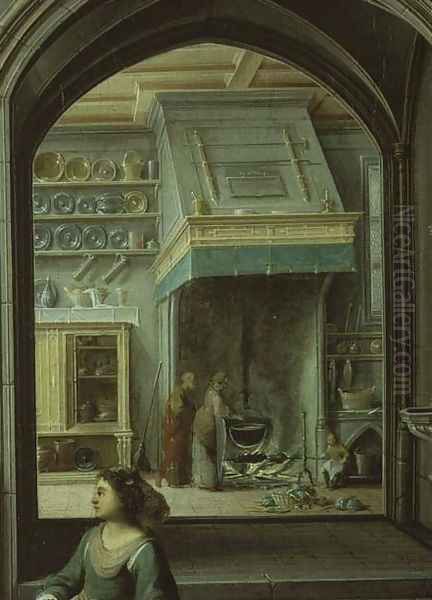
He also maintained connections with Frankfurt, a city that remained important for its publishing trade and its network of artists. It was in Frankfurt that he likely encountered the influential De Bry family of engravers and publishers. This connection may have facilitated his access to, and study of, the works of earlier German masters like Albrecht Dürer, whose mastery of perspective and printmaking was legendary.
Perhaps the most significant phase of his career unfolded in London, where he is documented from around 1617. He appears to have spent a considerable period in England, possibly until the late 1630s, before returning to the Low Countries. In London, he found favor at the court of King Charles I, a renowned connoisseur and patron of the arts. His sophisticated architectural scenes appealed to the refined tastes of the English aristocracy. The royal inventory of Charles I listed several works by Steenwyck, indicating his esteemed position. His time in London also brought him into contact with other prominent artists working for the English court, most notably Anthony van Dyck.
Signature Style and Technical Prowess
The distinctive style of Hendrick van Steenwyck the Younger is defined by several key characteristics. His command of perspective was paramount. He typically employed a central vanishing point, creating deep, receding spaces that guide the viewer's eye through complex architectural arrangements. This mathematical precision was combined with an acute sensitivity to the play of light and shadow.
His church interiors, often Gothic in style, are frequently bathed in a cool, diffused light filtering through high windows, or dramatically illuminated by candlelight in evening or night scenes. This use of chiaroscuro not only enhanced the three-dimensionality of the architecture but also imbued his scenes with a palpable atmosphere. Works like "A Church Interior by Night with a Procession" exemplify this skill, where the flickering torches cast long shadows and highlight specific architectural features, creating a sense of mystery and solemnity.
The figures populating his scenes are generally small in scale, serving to emphasize the grandeur of the surrounding architecture rather than being the primary focus. These figures, often elegantly dressed and engaged in quiet conversation or contemplation, add a human element and a sense of scale to the vast interiors. It is well-documented that Steenwyck frequently collaborated with other artists who specialized in figure painting. Members of the prolific Francken family, particularly Frans Francken II, are often credited with painting the staffage in his works. This collaborative practice was common in Antwerp and allowed artists to combine their respective strengths.
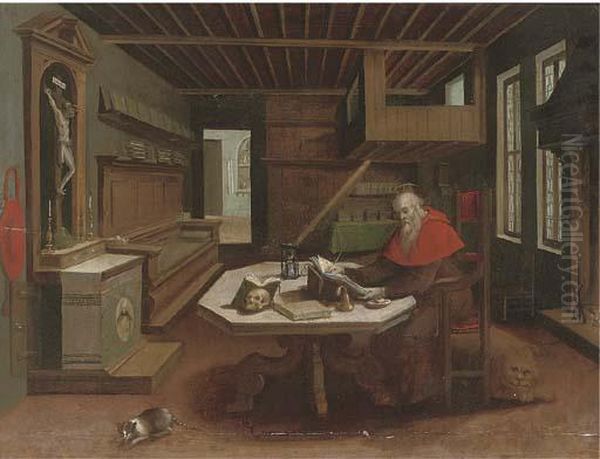
His palette was often subtle, with a preference for cool grays, browns, and ochres for the stonework, enlivened by touches of color in the stained glass or the attire of the figures. The brushwork is typically fine and meticulous, rendering architectural details with remarkable clarity and precision, even in his smaller cabinet-sized paintings.
Notable Works and Their Characteristics
Several key works illustrate Hendrick van Steenwyck the Younger's artistic achievements. His "Liberation of St. Peter," with versions found in collections such as the Kunsthistorisches Museum in Vienna, is a recurring theme that allowed him to showcase his skill in depicting dramatic nocturnal scenes within prison interiors. The interplay of divine light and the gloom of the dungeon creates a powerful narrative and visual impact.
"Jesus with Martha and Mary" (often titled "Christ in the House of Martha and Mary"), with a notable version in the Musée du Louvre, Paris, places a biblical scene within an elaborate domestic or palatial interior. While the religious narrative is present, the architectural setting, with its receding colonnades and detailed furnishings, commands significant attention, showcasing Steenwyck's ability to integrate narrative with his primary architectural focus.
The "Crucifixion," such as the panel in the National Gallery, London, demonstrates how he could adapt his architectural skills to outdoor scenes with significant architectural backdrops. Here, the cityscape or temple structures frame the central religious event, adding to its gravitas and historical context.
"Saint Jerome in His Study" is another theme he explored, allowing for the depiction of intricate, scholarly interiors filled with books, scientific instruments, and architectural details. These works appealed to a learned audience and highlighted the contemplative aspect of intellectual pursuit within an ordered, man-made environment. "Two Figures in a Church Interior" represents a more straightforward example of his primary subject, focusing on the grandeur and serenity of a sacred space, with figures serving to animate the scene and provide scale.
Many of his works are simply titled "Church Interior" or "Palace Interior," followed by a description of the lighting (e.g., "by Day," "by Night," "by Candlelight"). These titles underscore the primacy of the architectural subject itself. His ability to create variations on these themes, each with a unique atmospheric quality, speaks to his inventive capacity within his chosen specialization.
Collaborations and Artistic Connections
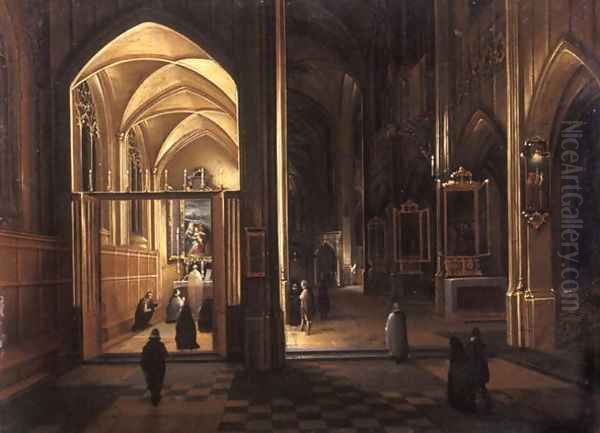
Collaboration was a hallmark of the Antwerp art scene, and Hendrick van Steenwyck the Younger was no exception. His most frequent collaborators for the figures in his paintings were members of the Francken family, such as Frans Francken II and possibly Hieronymus Francken II. These figures, though small, were essential for animating the scenes and providing a narrative or genre element.
He also collaborated with Jan Brueghel the Elder, a renowned flower and landscape painter. A notable example of their joint work is "Croesus and Solon," where Steenwyck would have painted the elaborate architectural setting, and Brueghel the figures and possibly other details. Such collaborations between specialists resulted in works of rich complexity and appeal.
His time in London brought him into the orbit of Anthony van Dyck, the leading court painter to Charles I. Van Dyck included a portrait of Steenwyck in his "Iconography," a series of engraved portraits of famous contemporaries. This inclusion is a testament to Steenwyck's high standing among his peers. While Van Dyck was primarily a portraitist, the sophisticated architectural backgrounds sometimes seen in his work may reflect a broader appreciation for this element, possibly influenced by specialists like Steenwyck.
Steenwyck's connections also extended to scholars and intellectuals. A letter written in 1632 to Theodoricus Gravius reveals an interest in alchemical texts, including "Wasserstein" and works by the mystic Jacob Böhme, such as "Explicatio." This suggests a mind engaged with the philosophical and esoteric currents of his time, adding another layer to his artistic persona beyond the purely technical aspects of his painting. His association with the De Bry family in Frankfurt, known for publishing travelogues and esoteric texts, further supports this intellectual curiosity. He also had connections with figures like Petrus Serrarius.
When preparing for his move to London, it's noted that Steenwyck strategically considered how to appeal to the English elite. This included not only his signature architectural pieces but also potentially leveraging comparisons with esteemed German masters like Albrecht Dürer and Albrecht Altdorfer to enhance his artistic status, perhaps through the medium of printmaking or by emphasizing the intellectual rigor of his perspectival constructions.
Printmaking and Wider Influence
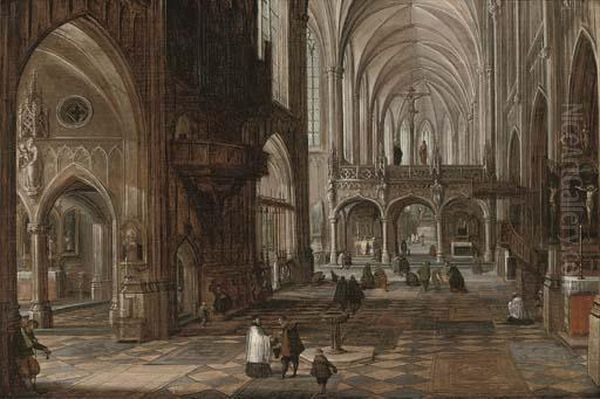
Beyond his paintings, Hendrick van Steenwyck the Younger also engaged in printmaking. This medium allowed for wider dissemination of his compositions and catered to a different segment of the art market. His prints, often etchings, translated his intricate architectural scenes into a monochrome format, emphasizing the linear qualities of his designs and his mastery of perspective. These prints would have helped to spread his style and influence other artists across Europe.
His work had a significant impact on subsequent generations of architectural painters. In the Dutch Republic, artists like Dirck van Delen, Bartholomeus van Bassen, and later, Emanuel de Witte and Pieter Saenredam, further developed the genre of architectural painting, each with their own distinct style. While Saenredam, for instance, focused on more austere and topographically accurate depictions of existing Dutch churches, the groundwork laid by pioneers like the Steenwycks in establishing architecture as a worthy subject in its own right was crucial. Pieter Neeffs the Elder and his son Pieter Neeffs the Younger also worked in a similar vein, specializing in church interiors in Antwerp.
The patronage he received from King Charles I and other English nobles, such as William III's friend for whom he painted a landscape for Ham House, ensured that his works were preserved in prominent collections. Today, his paintings are held in major museums worldwide, including the National Gallery in London, the Louvre in Paris, the Rijksmuseum in Amsterdam, the Kunsthistorisches Museum in Vienna, and the J. Paul Getty Museum in Los Angeles, among many others.
A Note on the Steenwyck Family Name and Still Life
While Hendrick van Steenwyck the Younger (and his father) specialized in architectural scenes, it is important to note that the Steenwyck family name is also associated with other artistic genres, particularly still life painting. Harmen van Steenwyck (c. 1612–c. 1656), likely a cousin or nephew of Hendrick the Younger (though the exact familial relationship is subject to art historical debate), became a distinguished still life painter active in Delft and Leiden. Harmen is particularly renowned for his "vanitas" still lifes, compositions laden with symbolic objects—such as skulls, hourglasses, extinguished candles, and books—alluding to the transience of life and the futility of earthly pursuits. This specialization is distinct from Hendrick the Younger's focus, highlighting the diverse talents within the broader Steenwyck artistic family.
Legacy and Historical Evaluation
Hendrick van Steenwyck the Younger is historically evaluated as a master of architectural painting, a genre he helped to define and popularize. His technical skill in rendering complex perspectives, his nuanced use of light to create atmosphere, and the sheer elegance of his compositions set a high standard for his contemporaries and successors. He successfully transitioned the architectural view from a mere backdrop to a captivating subject in its own right.
His ability to evoke both the grandeur of public and religious spaces and the intimacy of imagined interiors resonated with patrons who appreciated not only the technical virtuosity but also the intellectual and contemplative qualities of his work. The blend of realism in detail with often fantastical overall compositions gave his paintings a unique appeal.
His international career, particularly his successful period in London, demonstrates the widespread demand for his specialized art. The inclusion of his works in prestigious collections, both historically and in the present day, affirms his enduring importance. As an art historian, one recognizes Hendrick van Steenwyck the Younger not just as a skilled craftsman, but as an innovator who significantly contributed to the diversification of subject matter in Netherlandish art, paving the way for future generations of architectural painters and leaving behind a body of work that continues to fascinate with its intricate beauty and illusionistic depth. His paintings remain a testament to the enduring power of architectural form to inspire awe and contemplation.